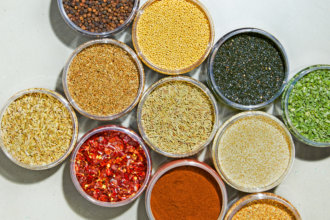How to Grow Your Own Herbs Indoors July 9, 2021
As the world starts to (fingers crossed) open up a bit more, there’s no better time to begin reclaiming your home as…your actual home. One of the best ways to stop languishing and start loving your space, in our humble opinion? Grow your own indoor herb garden.
Hear us out: starting an herb garden at home is the refresh we all need. What’s better than being surrounded with the color green, the ability to pluck a few sprigs of freshness to garnish a meal, the smell of herbaceous bliss? Having that all inside.
A home herb garden will instantly upgrade your cooking, create a new home aesthetic (hello, getting to pick out fun pots!), and allow you to pick up a new at-home hobby that’s actually fun. Picture yourself picking some basil from your windowsill to garnish a cocktail that’s being served to friends you haven’t hosted in over a year. Have we convinced you yet? Read on for our tips on how to get your garden off the ground (pun intended), plus some recipes for any herb occasion. We’re focusing on scallions, mint, basil, and thyme, but once you know the basics, sky’s the limit.
4 Quick Tips to Start Your Home Garden
1. Ditch the planting part altogether & regrow your herbs.
Bonus points for you if you want to spend time buying seeds, potting, making a drainage system, and waiting for your herbs to grow. If you want a fast pass, however (and no shame in that), you can regrow your herbs.
Scallions—one of our favorite herbs, if you couldn’t tell by perusing our menu—regrow in no time, and are absolutely fuss-free. To start, place the root end (the part we normally tell you to throw away) in a small glass of water. Make sure the roots are fully submerged and that some of the white bulb is sticking up above the top of the water. Other than switching out the water every 1-2 days, you can leave your scallions alone and let them do their thing. In a week or so, the scallion greens should have shot back to life.
2. Don’t overwater: your herbs aren’t that thirsty.
An overwatered plant is not a happy one. As people who are very into hydration (and also very into eating—full bellies = happy bellies over here!) this took a while to get used to. Depending on the type, you’ll want to water your plant every 1-2 weeks. And watch out for yellowing leaves: this is your herb child telling you they’re too full.
A cheater’s guide to how often to water your plants: scallions = once a week, mint = one to two times per week, basil = once every week or two, thyme = once every week or two.
3. Sunlight is your friend.
Generally speaking, herbs love basking in the sun. To get them tanning properly, locate your sunniest window (south-facing, preferably!), windowsill, or section of a balcony. If you live in an apartment building regularly cast in shadow, play detective for a few days and find the window with the most light streaming through each day.
4. Pruning is a good thing.
We mean it. Herbs need to be pruned to keep them healthy. If you spend too much time looking at your herb garden and not enough time using it, the roots will overgrow the pot. If that sounds bad, it’s because it is. Overgrown roots can cause a plant to die, undermining this whole new “I’m an herb parent now!” attitude.
How do you know when to snip, pick, and pluck?
Scallions: snip once greens are a few inches tall
Mint: pick once plant is about 4 inches high, and be sure to pinch off the whole stem
Basil: prune once plant is 6-8 inches tall (and watch out for white flowers, which are a sign of overgrowth)
Thyme: harvest whole sprigs just as leaves start to flower
How to Use Your Herbs
Now that you’ve mastered the art of growing your herbs, it’s time to put on that plucky personality and head into the kitchen. Here are 4 ways to take mealtime from sustenance to food using your home-grown herbs:
Easy Scallion Pancakes
Ingredients:
- 2 cups All-Purpose Flour, plus extra for kneading and rolling out your dough
- 1 ¼ cups Boiling Water
- 1 ¼ cups Scallions, thinly sliced
- 2 tbsp Toasted Sesame Oil
- Sea Salt
- Cooking Oil, for frying
Instructions:
- Combine 2 cups flour and a few pinches of salt in a medium bowl, then add boiling water and mix until a shaggy dough forms. Knead for 5 minutes. Place a damp towel over top, then let rest at room temperature about 30 minutes.
- Divide dough into four equal-sized balls. Working one at a time, roll out on a lightly-floured surface until ¼ inch thick. Brush with a thin layer of sesame oil and sprinkle generously with scallions. Roll dough away from you into a thin cylinder (like a jelly roll), then roll onto itself into a coil (like a cinnamon bun). Repeat with remaining dough.
- Heat a generous amount of cooking oil in a large pan over medium heat. Working one coil at a time, roll dough out into thin pancakes, just under ¼ inch each.
- Working one pancake at a time, fry until golden brown and crisp, about 3 minutes per side. Transfer to a paper towel-lined plate. Let cool, then cut into slices.
Mint Julep
Check out this recipe to make your own Mint Julep!
Quick Homemade Basil Pesto
Toss 2 cups fresh basil leaves, 2 cloves peeled garlic, 3 tbsp pine nuts or walnuts, ⅓ cup olive oil, ⅓ cup Parmesan, a squeeze of lemon juice, and a generous pinch of salt and pepper in a food processor or blender. Blend until smooth. Use in pasta, spread onto grilled cheese, or bake on top of salmon.
Lemon Thyme Marinade
Combine 2 tablespoons finely chopped thyme leaves, 4 smashed garlic cloves, zest and juice of one lemon, 2 tablespoons olive oil, 1 teaspoon kosher salt, and ½ teaspoon black pepper. Use to marinate chicken, pork, or mushrooms.
Feeling inspired? It’s thyme to pick up this newly minted hobby (yep, we went there) and refresh your kitchen with the smell of your own home-grown herbs.












